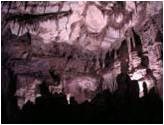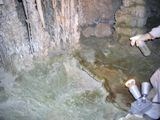Unnatural AlgaeAs you take a tour of Lehman Caves, you might notice some green looking areas along the trail. Most people see this and immediately think they have discovered copper, but what you are seeing is in fact an unnatural algae growth that plagues show caves, including Lehman Caves.The natural state of any cave is complete and total darkness. No light should exist deep within a cave system. Adding artificial lights to a cave upsets the delicate cave ecosystem, but are necessary to allow for people to safely enjoy these natural wonders. Since the first electric cave lights were installed in Lehman Caves in 1941, incandescent bulbs have been the lighting fixture of choice. Incandescent bulbs last an average of 200 hours, are fragile, operate at high temperatures and consume an average of 11,200 watts of power in the cave. They also give off yellow tinted light that hides the true color of cave formations and encourages algae growth. 
NPS PHOTO Damage to the CaveAlgae is problematic for cave ecosystems. Algae deposits introduce an invasive food source into the cave ecosystem, and greatly affect the natural balance of cave life. Algae growth can also harm the cave, as algae can permanently change the color of the cave, and even waterproof formations and prevent them from ever growing again.LightingDuring 2006, park staff have replaced the incandescent bulbs with Light EmittingDiodes (LEDs). LEDs last an average of 50,000 hours, are resistant to shock, operate at low temperatures, and consume one third the amount of electricity. The truer color rendition of LED’s show off the caves wide range of colors and should reduce algae growth. 
NPS PHOTO Until a more ideal lighting system is found, crews must regularly enter the cave to clean and remove the algae growths. Using nothing more than a spray bottle filled with a very diluted bleach solution, cave managers and volunteers meticulously wipe up these unnatural growths before they permanently damage the cave system. |
Last updated: April 24, 2021
